Pioneer HTS-260 Manual

HTS-260
SX-SW260
S-ST404
Audio Multi-channel Receiver Subwoofer Caisson de basse de rècepteur multi-voies audio
Speaker System
Enceintes Acoustiques
Register Your Product at
www.pioneerelectronics.com (US) www.pioneerelectronics.ca (Canada)
Operating Instructions
Mode d’emploi
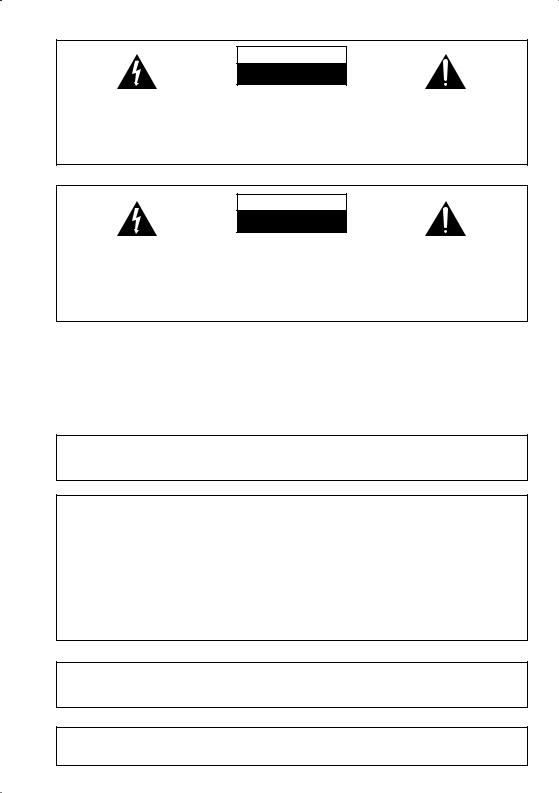
CAUTION
The lightning flash with arrowhead, within an equilateral triangle, is intended to alert the user to the presence of uninsulated "dangerous voltage" within the product's enclosure that may be of sufficient magnitude to constitute a risk of electric shock to persons.
RISK OF ELECTRIC SHOCK
DO NOT OPEN
CAUTION:
TO PREVENT THE RISK OF ELECTRIC SHOCK, DO NOT REMOVE COVER (OR BACK). NO USER-SERVICEABLE PARTS INSIDE. REFER SERVICING TO QUALIFIED SERVICE PERSONNEL.
The exclamation point within an equilateral triangle is intended to alert the user to the presence of important operating and maintenance (servicing) instructions in the literature accompanying the appliance.
D1-4-2-3_En
ATTENTION
Ce symbole de l’éclair, placé dans un triangle équilatéral, a pour but d’attirer l’attention de l’utilisateur sur la présence, à l’intérieur du coffret de l’appareil, de “tensions dangereuses” non isolées d’une grandeur suffisante pour représenter un risque d’électrocution pour les êtres humains.
DANGER D´ELECTROCUTION
NE PAS OUVRIR
ATTENTION:
POUR ÉVITER TOUT RISQUE D’ÉLECTROCUTION, NE PAS ENLEVER LE COUVERCLE (NI LE PANNEAU ARRIÈRE). AUCUNE PIÈCE RÉPARABLE PAR L’UTILISATEUR NE SE TROUVE À L’INTÉRIEUR. CONFIER TOUT ENTRETIEN À UN PERSONNEL QUALIFIÉ UNIQUEMENT.
Ce point d’exclamation, placé dans un triangle équilatéral, a pour but d’attirer l’attention de l’utilisateur sur la présence, dans les documents qui accompagnent l’appareil, d’explications importantes du point de vue de l’exploitation ou de l’entretien.
D1-4-2-3_Fr
WARNING – TO PREVENT FIRE OR SHOCK HAZARD, DO NOT EXPOSE THIS APPLIANCE TO RAIN OR MOISTURE.
D1-4-2-1_En
AVERTISSEMENT
Cet appareil n’est pas étanche. Pour éviter les risques d’incendie et de décharge électrique, ne placez près de lui un récipient rempli d’eau, tel qu’un vase ou un pot de fleurs, et ne l’exposez pas à des gouttes d’eau, des éclaboussures, de la pluie ou de l’humidité.
CAUTION: This product satisfies FCC regulations when shielded cables and connectors are used to connect the unit to other equipment. To prevent electromagnetic interference with electric appliances such as radios and televisions, use shielded cables and connectors for connections.
NOTE: This equipment has been tested and found to comply with the limits for a Class B digital device, pursuant to Part 15 of the FCC Rules. These limits are designed to provide reasonable protection against harmful interference in a residential installation. This equipment generates, uses, and can radiate radio frequency energy and, if not installed and used in accordance with the instructions, may cause harmful interference to radio communications. However, there is no guarantee that interference will not occur in a particular installation. If this equipment does cause harmful interference to radio or television reception, which can be determined by turning the equipment off and on, the user is encouraged to try to correct the interference by one or more of the following measures:
–Reorient or relocate the receiving antenna.
–Increase the separation between the equipment and receiver.
–Connect the equipment into an outlet on a circuit different from that to which the receiver is connected.
– Consult the dealer or an experienced radio/TV technician for help.
D8-10-1-2_En
Information to User
Alteration or modifications carried out without appropriate authorization may invalidate the user’s right to operate the equipment.
IMPORTANT NOTICE – THE SERIAL NUMBER FOR THIS EQUIPMENT IS LOCATED IN THE REAR.
PLEASE WRITE THIS SERIAL NUMBER ON YOUR ENCLOSED WARRANTY CARD AND KEEP IN A SECURE AREA. THIS IS FOR YOUR SECURITY.
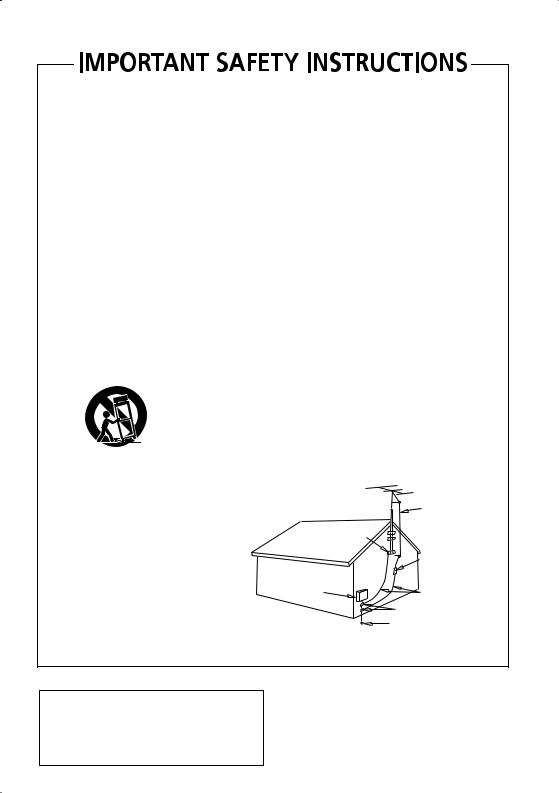
READ INSTRUCTIONS — All the safety and operating instructions should be read before the product is operated.
RETAIN INSTRUCTIONS — The safety and operating instructions should be retained for future reference.
HEED WARNINGS — All warnings on the product and in the operating instructions should be adhered to.
FOLLOW INSTRUCTIONS — All operating and use instructions should be followed.
CLEANING — The product should be cleaned only with a polishing cloth or a soft dry cloth. Never clean with furniture wax, benzine, insecticides or other volatile liquids since they may corrode the cabinet.
ATTACHMENTS — Do not use attachments not recommended by the product manufacturer as they may cause hazards.
WATER AND MOISTURE — Do not use this product near water — for example, near a bathtub, wash bowl, kitchen sink, or laundry tub; in a wet basement; or near a swimming pool; and the like.
ACCESSORIES — Do not place this product on an unstable cart, stand, tripod, bracket, or table. The product may fall, causing serious injury to a child or adult, and serious damage to the product. Use only with a cart, stand, tripod, bracket, or table recommended by the manufacturer, or sold with the product. Any mounting of the product should follow the manufacturer’s instructions, and should use a mounting accessory recommended by the manufacturer.
CART — A product and cart combination should be moved with care. Quick stops, excessive force, and uneven surfaces may cause the product and cart combination to overturn.
VENTILATION — Slots and openings in the cabinet are provided for ventilation and to ensure reliable operation of the product and to protect it from overheating, and these openings must not be blocked or covered. The openings should never be blocked by placing the product on a bed, sofa, rug, or other similar surface. This product should not be placed in a built-in installation such as a bookcase or rack unless proper ventilation is provided or the manufacturer’s instructions have been adhered to.
POWER SOURCES — This product should be operated only from the type of power source indicated on the marking label. If you are not sure of the type of power supply to your home, consult your product dealer or local power company.
LOCATION – The appliance should be installed in a stable location.
NONUSE PERIODS – The power cord of the appliance should be unplugged from the outlet when left un-used for a long period of time.
GROUNDING OR POLARIZATION |
OBJECT AND LIQUID ENTRY — Never push |
• If this product is equipped with a polarized |
objects of any kind into this product through |
alternating current line plug (a plug having one |
openings as they may touch dangerous voltage |
blade wider than the other), it will fit into the |
points or short-out parts that could result in a |
outlet only one way. This is a safety feature. If |
fire or electric shock. Never spill liquid of any |
you are unable to insert the plug fully into the |
kind on the product. |
outlet, try reversing the plug. If the plug should |
SERVICING — Do not attempt to service this |
still fail to fit, contact your electrician to replace |
product yourself as opening or removing covers |
your obsolete outlet. Do not defeat the safety |
may expose you to dangerous voltage or other |
purpose of the polarized plug. |
hazards. Refer all servicing to qualified service |
• If this product is equipped with a three-wire |
personnel. |
grounding type plug, a plug having a third |
DAMAGE REQUIRING SERVICE — Unplug this |
(grounding) pin, it will only fit into a grounding |
product from the wall outlet and refer servicing |
type power outlet. This is a safety feature. If you |
to qualified service personnel under the |
are unable to insert the plug into the outlet, |
following conditions: |
contact your electrician to replace your obsolete |
• When the power-supply cord or plug is |
outlet. Do not defeat the safety purpose of the |
damaged. |
grounding type plug. |
• If liquid has been spilled, or objects have fallen |
POWER-CORD PROTECTION — Power-supply |
into the product. |
cords should be routed so that they are not likely |
• If the product has been exposed to rain or water. |
to be walked on or pinched by items placed |
• If the product does not operate normally by |
upon or against them, paying particular |
following the operating instructions. Adjust only |
attention to cords at plugs, convenience |
those controls that are covered by the operating |
receptacles, and the point where they exit from |
instructions as an improper adjustment of other |
the product. |
controls may result in damage and will often |
OUTDOOR ANTENNA GROUNDING — If an |
require extensive work by a qualified technician |
outside antenna or cable system is connected to |
to restore the product to its normal operation. |
the product, be sure the antenna or cable |
• If the product has been dropped or damaged in |
system is grounded so as to provide some |
any way. |
protection against voltage surges and built-up |
• When the product exhibits a distinct change in |
static charges. Article 810 of the National |
performance — this indicates a need for service. |
Electrical Code, ANSI/NFPA 70, provides |
REPLACEMENT PARTS — When replacement parts |
information with regard to proper grounding of |
are required, be sure the service technician has |
the mast and supporting structure, grounding of |
used replacement parts specified by the |
the lead-in wire to an antenna discharge unit, |
manufacturer or have the same characteristics |
size of grounding conductors, location of |
as the original part. Unauthorized substitutions |
antenna-discharge unit, connection to |
may result in fire, electric shock, or other |
grounding electrodes, and requirements for the |
hazards. |
grounding electrode. See Figure A. |
SAFETY CHECK — Upon completion of any service |
LIGHTNING — For added protection for this |
or repairs to this product, ask the service |
product during a lightning storm, or when it is |
technician to perform safety checks to |
left unattended and unused for long periods of |
determine that the product is in proper |
time, unplug it from the wall outlet and |
operating condition. |
disconnect the antenna or cable system. This |
WALL OR CEILING MOUNTING — The product |
will prevent damage to the product due to |
should not be mounted to a wall or ceiling. |
lightning and power-line surges. |
HEAT — The product should be situated away from |
POWER LINES — An outside antenna system |
heat sources such as radiators, heat registers, |
should not be located in the vicinity of overhead |
stoves, or other products (including amplifiers) |
power lines or other electric light or power |
that produce heat. |
circuits, or where it can fall into such power |
|
lines or circuits. When installing an outside |
|
antenna system, extreme care should be taken |
|
to keep from touching such power lines or |
|
circuits as contact with them might be fatal. |
|
OVERLOADING — Do not overload wall outlets, |
|
extension cords, or integral convenience |
|
receptacles as this can result in a risk of fire or |
ANTENNA |
electric shock. |
|
|
LEAD IN |
|
WIRE |
|
GROUND |
|
CLAMP |
|
ANTENNA |
|
DISCHARGE UNIT |
|
(NEC SECTION 810-20) |
ELECTRIC |
|
SERVICE |
GROUNDING CONDUCTORS |
EQUIPMENT |
(NEC SECTION 810-21) |
|
GROUND CLAMPS |
Fig. A |
POWER SERVICE GROUNDING |
ELECTRODE SYSTEM |
|
|
(NEC ART 250, PART H) |
|
NEC — NATIONAL ELECTRICAL CODE |
|
D1-4-2-2_En |
This product is for general household purposes. Any failure due to use for other than household purposes (such as long-term use for business purposes in a restaurant or use in a car or ship) and which requires repair will be charged for even during the warranty period.
This product contains mercury. Disposal of this material may be regulated due to environmental considerations. For disposal or recycling information, please contact your local authorities or the Electronics Industries Alliance : www.eiae.org.

POWER-CORD CAUTION
Handle the power cord by the plug. Do not pull out the plug by tugging the cord and never touch the power cord when your hands are wet as this could cause a short circuit or electric shock. Do not place the unit, a piece of furniture, etc., on the power cord, or pinch the cord. Never make a knot in the cord or tie it with other cords. The power cords should be routed such that they are not likely to be stepped on. A damaged power cord can cause a fire or give you an electrical shock. Check the power cord once in a while. When you find it damaged, ask your nearest PIONEER authorized service center or your dealer for a replacement.
NOTE IMPORTANTE SUR LE CABLE D’ALIMENTATION
Tenir le câble d’alimentation par la fiche. Ne pas débrancher la prise en tirant sur le câble et ne pas toucher le câble avec les mains mouillées. Cela risque de provoquer un court-circuit ou un choc électrique. Ne pas poser l’appareil ou un meuble sur le câble. Ne pas pincer le câble. Ne pas faire de noeud avec le câble ou l’attacher à d’autres câbles. Les câbles d’alimentation doivent être posés de façon à ne pas être écrasés. Un câble abîmé peut provoquer un risque d’incendie ou un choc électrique. Vérifier le câble d’alimentation de temps en temps. Contacter le service après-vente PIONEER le plus proche ou le revendeur pour un remplacement.
WARNING: Handling the cord on this product or cords associated with accessories sold with the product will expose you to chemicals listed on proposition 65 known to the State of California and other governmental entities to cause cancer and birth defect or other reproductive harm.
Wash hands after handling |
D36-P4_A_En |
For U.S. and Australia Model
C67-7-3_En
Ce produit est destiné à une utilisation domestique générale. Toute panne due à une utilisation autre qu'à des fins privées (comme une utilisation à des fins commerciales dans un restaurant, dans un autocar ou sur un bateau) et qui nécessite une réparation sera aux frais du client, même pendant la période de garantie.
CAUTION – PREVENT ELECTRIC SHOCK DO NOT USE THIS (POLARIZED) PLUG WITH AN EXTENSION CORD. RECEPTACLE OR OTHER OUTLET UNLESS THE BLADES CAN BE FULLY INSERTED TO PREVENT BLADE EXPOSURE.
ATTENTION – POUR PREVENIR LES CHOCS ELECTRIQUES NE PAS UTILISER CETTE FICHE POLARISEE AVEC UN PROLONGATEUR UNE PRISE DE COURANT OU UNE AUTRE SORTIE DE COURANT, SAUF SI LES LAMES PEUVENT ETRE INSEREES A FOND SANS EN LAISSER AUCUNE PARTIE A DECOUVVERT.
This Class B digital apparatus complies with Canadian ICES-003.
Cet appareil numérique de la Classe B est conforme à la norme NMB-003 du Canada.
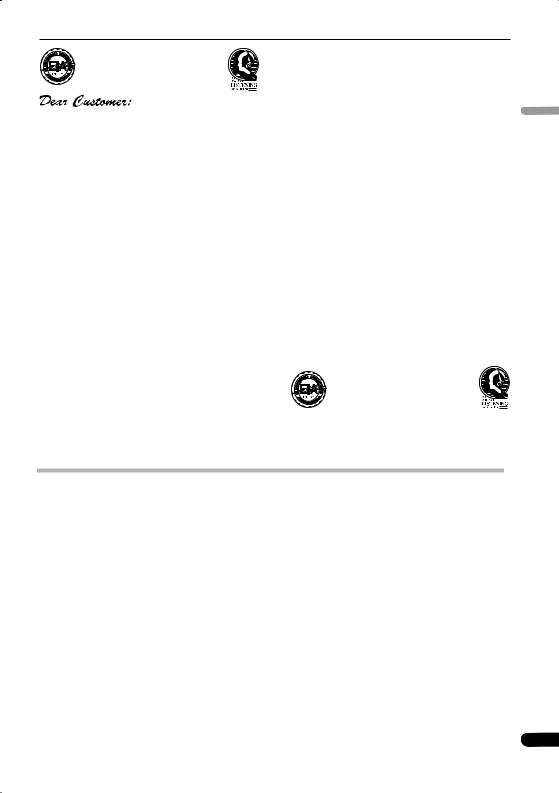
Selecting fine audio equipment such as the unit you’ve just purchased is only the start of your musical enjoyment. Now it’s time to consider how you can maximize the fun and excitement your equipment offers. This manufacturer and the Electronic Industries Association’s Consumer Electronics Group want you to get the most out of your equipment by playing it at a safe level. One that lets the sound come through loud and clear without annoying blaring or distortion-and, most importantly, without affecting your sensitive hearing.
Sound can be deceiving. Over time your hearing “comfort level” adapts to higher volumes of sound. So what sounds “normal” can actually be loud and harmful to your hearing. Guard against this by setting your equipment at a safe level BEFORE your hearing adapts.
To establish a safe level:
•Start your volume control at a low setting.
•Slowly increase the sound until you can hear it comfortably and clearly, and without distortion.
Once you have established a comfortable sound level:
• Set the dial and leave it there.
Taking a minute to do this now will help to prevent hearing damage or loss in the future. After all, we want you listening for a lifetime.
We Want You Listening For A Lifetime
Used wisely, your new sound equipment will provide a lifetime of fun and enjoyment. Since hearing damage from loud noise is often undetectable until it is too late, this manufacturer and the Electronic Industries Association’s Consumer Electronics Group recommend you avoid prolonged exposure to excessive noise. This list of sound levels is included for your protection.
Decibel
Level Example
30 Quiet library, soft whispers
40 Living room, refrigerator, bedroom away from traffic
50 Light traffic, normal conversation, quiet office
60 Air conditioner at 20 feet, sewing machine
70 Vacuum cleaner, hair dryer, noisy restaurant
80Average city traffic, garbage disposals, alarm clock at two feet.
THE FOLLOWING NOISES CAN BE DANGEROUS UNDER CONSTANT EXPOSURE
90 Subway, motorcycle, truck traffic, lawn mower
100 Garbage truck, chain saw, pneumatic drill
120 Rock band concert in front of speakers, thunderclap
140 Gunshot blast, jet plane
180 Rocket launching pad
Information courtesy of the Deafness Research Foundation.
S001_En
What’s in the box
Please confirm that the following items are all supplied.
Receiver subwoofer (SX-SW260) box:
•Remote control (page 15)
•AA/R6 dry cell batteries (to confirm operation) x2 (page 16)
•Display unit (page 14)
•Power cord (page 12)
•AM loop antenna (page 11)
•FM wire antenna (page 11)
•Display cable (page 11)
•Coaxial cable (page 27)
•Microphone (for Auto MCACC setup) (page 17)
•These operating instructions
•Warranty card
Speakers (S–ST404) box:
•Speakers (front x2, surround x2, center x1) (page 12)
•Speaker cables x5 (page 11)
•Non-skid pads (large) x4 (page 7, 8)
•Non-skid pads (small) x20 (page 7, 8)
•Speaker stands x2 (page 8)
•Screws (for speaker stands) x2 (page 8)
English
5
En

Contents
Thank you for buying this Pioneer product.
Please read through these operating instructions so that you will know how to operate your model properly. After you have finished reading the instructions, put them in a safe place for future reference.
Contents
What’s in the box . . . . . . . . . . . . . . . . . . . . . . . . . . . . .5
01 Speaker Setup Guide
Safety precautions when setting up . . . . . . . . . . . . . . .7
Home theater sound setup . . . . . . . . . . . . . . . . . . . . . .7 Standard surround setup . . . . . . . . . . . . . . . . . . . . . .7 Front surround setup . . . . . . . . . . . . . . . . . . . . . . . . .8
Wall mounting the speakers . . . . . . . . . . . . . . . . . . . . .9
Before mounting . . . . . . . . . . . . . . . . . . . . . . . . . . . .9
Wall mounting the center speaker . . . . . . . . . . . . . . .9 Wall mounting the other speakers . . . . . . . . . . . . . . .9 Additional notes on speaker placement . . . . . . . . . . . .9
02 Connecting up
Basic connections . . . . . . . . . . . . . . . . . . . . . . . . . . .10
Wall mounting the display unit. . . . . . . . . . . . . . . . .13 Using this system for TV audio . . . . . . . . . . . . . . . . . .13
03 Controls and displays
Display unit . . . . . . . . . . . . . . . . . . . . . . . . . . . . . . . .14 Display . . . . . . . . . . . . . . . . . . . . . . . . . . . . . . . . . . .14 Remote control. . . . . . . . . . . . . . . . . . . . . . . . . . . . . .15 Using the remote control . . . . . . . . . . . . . . . . . . . . . .16
Putting the batteries in the remote control . . . . . . . . .16
04 Getting started
System demo setting . . . . . . . . . . . . . . . . . . . . . . . . .17
Using the Auto MCACC setup for optimal surround sound . . . . . . . . . . . . . . . . . . . . . . . . . . . . . . . . . . . . .17
05 Listening to your system
Auto listening mode . . . . . . . . . . . . . . . . . . . . . . . . . .19
Listening in surround sound. . . . . . . . . . . . . . . . . . . .19 Dolby Pro Logic II Music settings . . . . . . . . . . . . . . .19
Using Front Surround. . . . . . . . . . . . . . . . . . . . . . . . .20 Using Advanced Surround . . . . . . . . . . . . . . . . . . . . .20 Listening in stereo . . . . . . . . . . . . . . . . . . . . . . . . . . .20 Using the Sound Retriever . . . . . . . . . . . . . . . . . . . . .21
Listening with Acoustic Calibration EQ. . . . . . . . . . . .21
Enhancing dialogue . . . . . . . . . . . . . . . . . . . . . . . . . .21
Using Quiet and Midnight listening modes . . . . . . . .21 Adjusting the bass and treble . . . . . . . . . . . . . . . . . . .21
Boosting the bass level. . . . . . . . . . . . . . . . . . . . . . . .22
06 Listening to the radio
Listening to the radio . . . . . . . . . . . . . . . . . . . . . . . . .23
Improving poor FM reception . . . . . . . . . . . . . . . . . .23
Improving poor AM sound . . . . . . . . . . . . . . . . . . . .23 Memorizing stations. . . . . . . . . . . . . . . . . . . . . . . . .23
Listening to station presets . . . . . . . . . . . . . . . . . . .23 Changing the frequency step . . . . . . . . . . . . . . . . . .24
07 Surround sound settings
Using the Setup menu . . . . . . . . . . . . . . . . . . . . . . . .25 Channel level setting . . . . . . . . . . . . . . . . . . . . . . . .25 Speaker distance setting . . . . . . . . . . . . . . . . . . . . .25 Dynamic Range Control . . . . . . . . . . . . . . . . . . . . . .25 Dual mono setting . . . . . . . . . . . . . . . . . . . . . . . . . .26
Adjusting the channel levels using the test tone. . . . .26
08 Other connections
Connecting auxiliary components . . . . . . . . . . . . . . .27 Connecting an analog audio component . . . . . . . . .27 Listening to an external audio source . . . . . . . . . . . . .27 Connecting external antennas . . . . . . . . . . . . . . . . . .27 Using this unit with a Pioneer plasma display . . . . . .28 SR+ Setup for Pioneer plasma displays. . . . . . . . . .28
Using the SR+ mode with a Pioneer plasma
display . . . . . . . . . . . . . . . . . . . . . . . . . . . . . . . . . . .29 About the control out jack . . . . . . . . . . . . . . . . . . . . .29
09 Additional information
Setting the sleep timer . . . . . . . . . . . . . . . . . . . . . . . .30 Dimming the display . . . . . . . . . . . . . . . . . . . . . . . . .30 DTS CD setting . . . . . . . . . . . . . . . . . . . . . . . . . . . . . .30 Resetting the system . . . . . . . . . . . . . . . . . . . . . . . . .30
Installation and maintenance . . . . . . . . . . . . . . . . . . .31
Hints on installation . . . . . . . . . . . . . . . . . . . . . . . . .31 Glossary . . . . . . . . . . . . . . . . . . . . . . . . . . . . . . . . . . .31
Setting up the remote to control your TV. . . . . . . . . . .31 Using the TV remote control buttons . . . . . . . . . . . .31
Preset code list . . . . . . . . . . . . . . . . . . . . . . . . . . . .32 Troubleshooting . . . . . . . . . . . . . . . . . . . . . . . . . . . . .33 General . . . . . . . . . . . . . . . . . . . . . . . . . . . . . . . . . .33 Tuner . . . . . . . . . . . . . . . . . . . . . . . . . . . . . . . . . . . .33 Error Messages . . . . . . . . . . . . . . . . . . . . . . . . . . . .34 Specifications. . . . . . . . . . . . . . . . . . . . . . . . . . . . . . .35
6
En
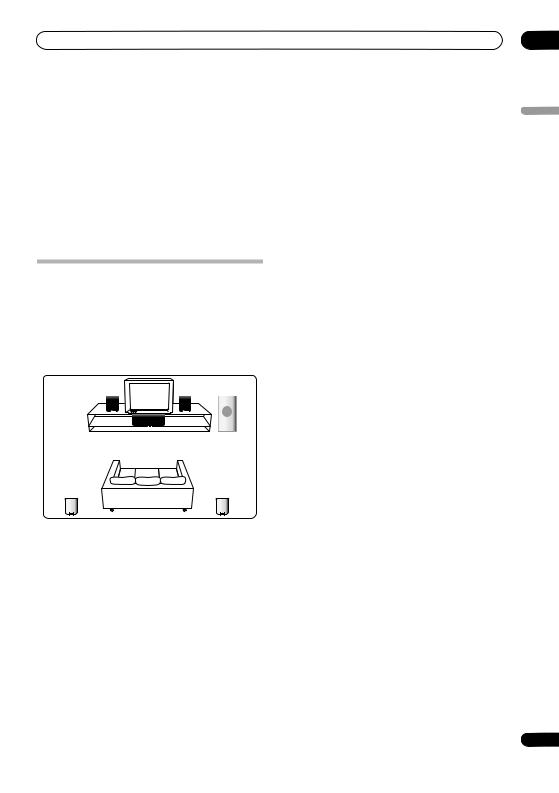
Speaker Setup Guide
Chapter 1
Speaker Setup Guide
|
1 Attach the smaller non-skid pads to the base of |
|
|
||
Safety precautions when setting up |
each of the front, surround and center speakers. The |
|
When assembling the speakers, lay them down flat on |
four large non-skid pads are for the receiver |
|
subwoofer (as shown). |
||
their side to avoid accidents or injury. Make sure to use a |
||
Use the adhesive side of the pads to attach them to the |
||
stable surface when assembling, setting up, and placing |
||
base (flat surface) of each speaker. |
||
the speakers. |
||
|
01
English
Home theater sound setup
Depending on the size and characteristics of your room, you can place your speakers in one of two ways using this system.
Standard surround setup
This is a standard multichannel surround sound speaker setup for optimal 5.1 channel home theater sound.
Front |
Front |
left |
right |
Center |
Receiver subwoofer |
Listening position |
|
Surround |
Surround |
left |
right |
Listening position |
|
Front and surround speakers
Non-skid pads (small) x 20
Center speaker
Non-skid pads (large) x 4
Receiver subwoofer
2 Connect the speaker system.
Refer to Connecting up to connect the speakers properly. After connecting everything, place the speakers as shown in the diagram (left) for optimal surround sound.
After placing the speakers, run the Auto MCACC setup (page 17) to complete your surround sound setup.
7
En

01 Speaker Setup Guide
Front surround setup
This setup is ideal when rear surround speaker placement isn't possible or you want to avoid running long speaker cables in your listening area. Use this setup together with the Front Surround modes in page 20 to take advantage of wall and ceiling reflections for a very realistic surround effect.
Surround left |
Surround |
|
right |
||
|
2 Attach the surround speakers to the speaker stands.
For each speaker, line up the spurs on the stand with the holes on the back of the speaker and insert, then secure the speaker to the stand with the screw provided.
Front left |
Center |
Front right |
Receiver |
|
|
|
subwoofer |
Listening position
1 Attach the smaller non-skid pads to the base of the front and center speakers and to the speaker stands. The four large non-skid pads are for the receiver subwoofer (as shown).
Use the adhesive side of the pads to attach them to the base (flat surface) of each speaker or stand.
Front speakers |
Speaker stands |
Non-skid pads (small) x 20
Center speaker
Non-skid pads |
Receiver |
(large) x 4 |
subwoofer |
8
3 Connect the speaker system.
Refer to Connecting up to connect the speakers properly. After connecting everything, place the speakers as shown in the diagram (left) for optimal surround sound (the surround speakers are next to the front speakers).
4 Turn the speakers as shown, following the guide marks for optimal Front Surround.
If you have selected FRTMOVIE (Front Surround Movie) or FRTMUSIC (Front Surround Music), turn each surround speaker so that the guide markers on the stand base are lined up horizontally in the direction the listening position (see below). With EXTPOWER (Extra Power), the surround speakers should point in the same direction as the front speakers (see below).
See Using Front Surround on page 20 for more information.
FRTMOVIE / FRTMUSIC
EXTPOWER
After placing the speakers, run the Auto MCACC setup (page 17) to complete your surround sound setup.
En
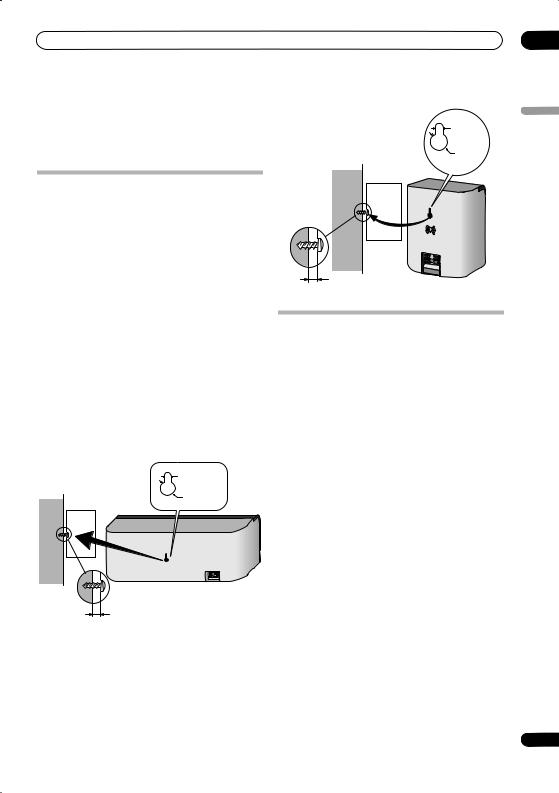
Speaker Setup Guide
 Caution
Caution
•Please don’t attach the surround speakers to the wall for Front surround setup.
Wall mounting the speakers
Before mounting
•Remember that the speaker system is heavy and that its weight could cause the screws to work loose, or the wall material to fail to support it, resulting in the speaker falling. Make sure that the wall you intend to mount the speakers on is strong enough to support them. Do not mount on plywood or soft surface walls.
•Mounting screws are not supplied. Use screws suitable for the wall material and support the weight of the speaker.
 Caution
Caution
•If you are unsure of the qualities and strength of the wall, consult a professional for advice.
•Pioneer is not responsible for any accidents or damage that result from improper installation.
Wall mounting the center speaker
The center speaker has a mounting hole which can be used to mount the speaker on the wall.
5 mm/3/16 in
10 mm/3/8 in
5 mm to 7 mm (3/16 in. to 1/4 in.)
Wall mounting the other speakers
In addition to the center speaker, the front and surround speakers also have holes for wall mounting. However, if you are using the Front Surround setup described on the previous page, do not wall mount the surround speakers.
5 mm/ 3/16 in.
10 mm/ 3/8 in.
5 mm to 7 mm (3/16 in. to 1/4 in.)
Additional notes on speaker placement
•Install the main front left and right speakers at an equal distance from the TV.
•For optimum effect, install the rear speakers slightly above ear level.
•Install the center speaker above or below the TV so that the sound of the center channel is localized at the TV screen.
Precautions:
•When installing the center speaker on top of the TV, be sure to secure it with tape or some other suitable means. Otherwise, the speaker may fall from the TV due to external shocks such as earthquakes, endangering those nearby or damaging the speaker.
•The front (L/R), center and surround (L/R) speakers supplied with this system are magnetically shielded. However, depending on the installation location, color distortion may occur if the speaker is installed extremely close to the screen of a television set. If this happens, turn the power switch of the television set OFF, and turn it ON after 15 min to 30 min. If the problem persists, place the speaker system away from the television set.
•The receiver subwoofer is not magnetically shielded and so should not be placed near a TV or monitor. Magnetic storage media (such as floppy discs and tape or video cassettes) should also not be kept close to the receiver subwoofer.
•Do not attach the receiver subwoofer to the wall or ceiling. They may fall off and cause injury.
•For safety, make sure that there is no exposed bare speaker wire outside of the speaker terminals.
•Do not connect the supplied speakers with any other amplifier. This may result in malfunction or fire.
•Do not connect any speakers other than those supplied to this system.
01
English
9
En

02 Connecting up
Chapter 2
Connecting up
Basic connections
 Important
Important
•When connecting this system or changing connections, be sure to switch power off and disconnect the power cord from the wall socket.
After completing all connections, connect the power cord to the wall socket.
Receiver subwoofer
 FM antenna
FM antenna
2 AM loop antenna
3
Display unit
|
ANTENNA |
|
MCACC |
CONTROL IN |
|
SETUP MIC |
FM |
AM |
|
||
|
UNBAL 75Ω |
LOOP ANTENNA |
|
|
|
|
|
|
|
AUDIO |
INPUT |
ANALOG |
|
|
CONTROL |
|
SPEAKERS |
|
|
DIGITAL |
|
|||
SYSTEM CONNECTOR |
|
|
DVD |
DTV |
PC/GAME |
AUX |
||||
OUT |
SUB WOOFER |
R SURROUND |
L |
|||||||
|
(COAXIAL) |
(OPTICAL) |
(OPTICAL) |
|
||||||
|
|
|
|
|
|
|
|
|
L |
|
USE ONLY WITH DISPLAY UNIT. |
|
|
|
|
|
|
|
R |
||
SEE INSTRUCTION MANUAL. |
|
|
|
|
|
|
|
|
||
|
|
CENTER |
R |
FRONT |
L |
|
|
|
|
|
AC IN |
|
|
|
|
|
|
|
|
|
|
1
Display cable
10
En

Connecting up |
02 |
1Connect the display unit to the receiver subwoofer.
Plug the L-shaped end of the display cable into the connector on the rear of the display unit, then plug the other end of the display cable into SYSTEM CONNECTOR jack on the receiver subwoofer.
2Assemble the AM loop antenna.
a
b
c
a.Bend the stand in the direction indicated by the arrow.
b.Clip the loop onto the stand.
c.If you want to fix to a wall or other surface, perform step b after first securing the stand with screws.
It is recommended that you determine the reception strength before securing the stand with the screws.
3Connect the AM and FM antennas1.
a.Connect one wire of the AM loop antenna to each AM antenna terminal2.
For each terminal, press down on the tab to open; insert the wire, then release to secure.
4Connect each speaker.
•Each speaker cable has a color-coded connector at one end and two wires at the other end.
Color-coded wire
(Connect to speaker)
Color-coded connector (Connect to rear panel)
•Twist and pull off the protective shields on each wire.
•Connect the wires to the speaker. Match the colored wired with the color-coded label (model label), then insert the colored wire into the red (+) side and the other wire into the black (–) side.
•Connect the other end to the color-coded speaker terminals on the rear of the receiver subwoofer. Make sure to insert completely.
The small lug at the wire-end of the speaker plug should face up or down depending on whether it’s being plugged into one of the upper or lower speaker terminals. Please make sure to connect correctly.
English
1


 2
2
Upper terminal |
Lower terminal |
b.Push the FM antenna3 plug onto the center pin of the FM antenna socket.
5Connect the subwoofer cable.
•Just below the subwoofer speaker, to the left of center, you should see the subwoofer connecting cable. Plug this into the SUBWOOFER SPEAKER terminal.
|
Note |
1 |
• Keep antenna cables away from other cables, the display unit and receiver subwoofer. |
|
• If reception with the supplied antenna is poor, see Improving poor FM reception and Improving poor AM sound on page 23 or Connecting |
|
external antennas on page 27. |
2 |
• Don’t let it come into contact with metal objects and avoid placing near computers, television sets or other electrical appliances. |
|
• The signal earth ( ) is designed to reduce noise that occurs when an antenna is connected. It is not an electrical safety earth. |
|
• If radio reception is poor, you may be able improve it by re-inserting each antenna wire into the opposite terminal. |
|
• For best reception, do not untwist the AM loop antenna wires or wrap them around the loop antenna. |
3 |
• To ensure optimum reception, make sure the FM antenna is fully extended and not coiled or hanging at the rear of the unit. |
11
En

02 Connecting up
 Caution
Caution
•These speaker terminals carry HAZARDOUS LIVE voltage. To prevent the risk of electric shock when connecting or disconnecting the speaker cables, disconnect the power cord before touching any uninsulated parts.
Receiver subwoofer
|
|
ANTENNA |
|
5 |
MCACC |
CONTROL IN |
|
SETUP MIC |
FM |
AM |
|
|
|||
|
UNBAL 75Ω |
LOOP ANTENNA |
|
|
|
R |
|
L |
4 |
AUDIO |
INPUT |
|
|
CONTROL |
|
SPEAKERS |
|
|
DIGITAL |
|
ANALOG |
|
SYSTEM CONNECTOR |
|
|
DVD |
DTV |
PC/GAME |
AUX |
|||
OUT |
SUB WOOFER |
|
SURROUND |
|
|||||
|
|
(COAXIAL) |
(OPTICAL) |
(OPTICAL) |
|
||||
|
|
|
|
||||||
|
|
|
|
|
|
|
|
|
L |
USE ONLY WITH DISPLAY UNIT. |
R |
SEE INSTRUCTION MANUAL. |
|
CENTER R FRONT L
AC IN
7 
 To AC outlet
To AC outlet
6If you have a DVD player or other source1 component you want to connect, connect it now before connecting the power cord in the next step.
See Connecting auxiliary components on page 27 for how to connect a digital source component.
7Connect the power cords.2
•Do not connect any speakers other than those supplied to this system.
•Do not connect the supplied speakers to any amplifier other than the one supplied with this system. Connection to any other amplifier may result in malfunction or fire.
Surround right |
Surround left |
(Gray) |
(Blue) |
Listening position
Front right |
Center (Green) |
Front left |
|
||
(Red) |
|
(White) |
•Connect the power cords to AC inlets on the receiver subwoofer. Connect the power cords to a wall socket.
 Note
Note
1Make sure to connect a TV or monitor (for video sources) to take advantage of this system’s home theater potential. Please refer to the instruction manual supplied with your TV or monitor for connection details.
2• Do not use any power cord other than the one supplied with this system.
• Do not use the supplied power cord for any purpose other than connecting to this system.
12
En
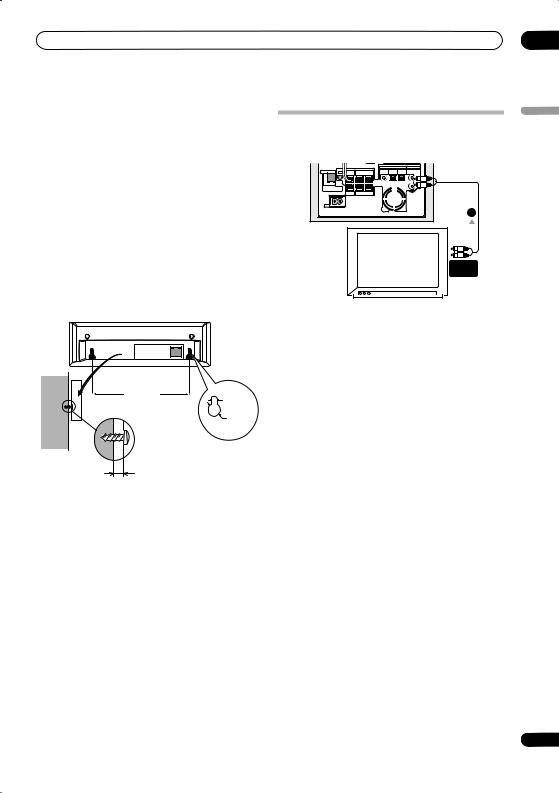
Connecting up
Wall mounting the display unit
It is possibe to mount the display unit on the wall.
Before mounting:
•Remember that the display unit is heavy and could cause the wood screws to work loose, or the wall material to fail to support it, resulting in the display falling. Make sure that the wall you intend to mount the display on is strong enough to support it. Do not mount on plywood or soft surface walls.
•Mounting screws are not supplied. Use screws that are suitable for the wall material and that will support the weight of the display.
•Pioneer bears no responsibility for accidents resulting from faulty assembly or installation, insufficient mounting strength of walls or other building fixtures, misuse or natural disasters.
•If you are unsure of the qualities and strength of the wall, consult a professional for advice.
5 27/32 in.
148.5 mm 5/32 in.
4 mm
3/8 in.
10 mm
Mounting screw (not supplied)
3/32 in./ 2.5 mm
Using this system for TV audio
If your TV has a stereo audio output you can connect it to this system and enjoy surround TV sound.
|
|
|
|
|
|
AUDIO |
INPUT |
|
|
CONTROL |
|
SPEAKERS |
|
|
DIGITAL |
|
ANALOG |
SYSTEM CONNECTOR |
|
|
DVD |
DTV |
PC/GAME |
AUX |
||
|
OUT |
SUB WOOFER |
R SURROUND |
L |
(COAXIAL) |
(OPTICAL) |
(OPTICAL) |
|
|
|
|
|
|
|
|
|
L |
USE ONLY WITH DISPLAY UNIT. |
R |
SEE INSTRUCTION MANUAL. |
|
CENTER R FRONT L
AC IN
1 |
AUDIO |
OUTPUT |
TV |
1 Connect the AUDIO OUTPUT jacks on your TV to the AUX AUDIO INPUT jacks on the receiver subwoofer.
Use the red/white stereo audio cable (not supplied) for this connection. Make sure you match the left and right outputs with their corresponding inputs for correct stereo sound.
•You can use the AUX input jacks for any analog source you want, such as a tape deck, etc.
02
English
13
En

03 Controls and displays
Chapter 3
Controls and displays
Display unit
– VOLUME + AUDIO INPUT SURROUND
 STANDBY/ON
STANDBY/ON
|
1 |
2 |
|
3 |
4 |
5 |
6 |
1 |
STANDBY/ON |
|
4 |
AUDIO INPUT (page 27) |
|
||
Press to switch the system on/into standby. |
|
Press repeatedly to select one of the external audio |
|||||
2 |
Front panel display |
|
inputs (DVD, DTV, PC/GAME or AUX). |
||||
|
|
|
|
|
|
||
See below for details. |
|
5 |
SURROUND |
|
|
|
|
3 |
VOLUME buttons |
|
Use to select a Surround mode (page 19). |
||||
|
|
|
|
|
|
||
Use to adjust the volume. |
|
6 |
IR remote sensor (page 16) |
||||
Display
1 |
2 |
3 |
|
|
SOUND |
|
|
DTS F.SURR. |
|
||
2D |
|
|
|
2PL |
|
|
|
9 |
8 |
7 |
6 |
1 DTS
Lights during playback of a DTS source (page 19).
2F.SURR.
Lights when one of the Front Surround listening modes is selected (page 20).
SURR.
Lights when one of the Advanced Surround listening modes is selected (page 20).
3SOUND
Lights when Sound Retriever is active (page 20).
4Tuner indicators

 – Lights when a broadcast is being received.
– Lights when a broadcast is being received.
 – Lights when a stereo FM broadcast is being received in auto stereo mode.
– Lights when a stereo FM broadcast is being received in auto stereo mode.
 – Lights when FM mono reception is selected.
– Lights when FM mono reception is selected.
kHz MHz
5 4
5 kHz / MHz
Indicates the frequency unit shown in the character display (kHz for AM, MHz for FM).
6Character display
7
Lights when sleep timer is active (page 30).
8 2 PL II
Lights during Dolby Pro Logic II decoding (page 19).
9 2 D
Lights during playback of a Dolby Digital source (page 19).
14
En
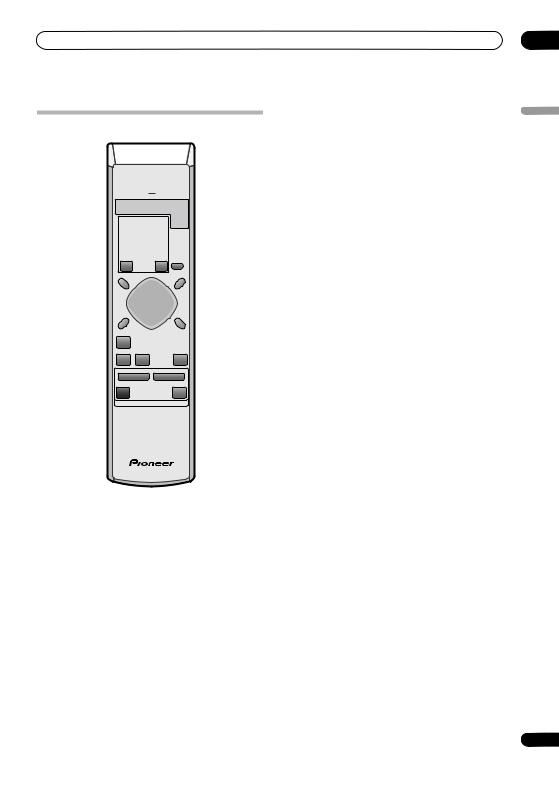
Controls and displays
Remote control
STANDBY/ON
1 |
|
|
MUTE |
|
2 |
|
VOLUME |
|
|
|
|
|
3 |
|
4 |
DVD |
DTV |
PC/GAME |
AUX |
|
|
|
|
|
|
|
|
|
TUNER |
5 |
|
|
|
|
|
|
|
|
SLEEP |
|
ENTER |
|
CLEAR |
6 |
7 |
SETUP |
|
|
SR |
|
|
TUNE |
8 |
|
9 |
ST |
|
ST |
|
|
ENTER |
|
||
|
|
|
|
TEST |
|
SOUND |
|
|
TONE |
10 |
|
|
TUNE |
|
SOUND |
|
|
11 |
|
|
RETRIEVER |
|
|
|
12 |
|
|
|
14 |
|
SURROUND |
ADVANCED |
MCACC |
|
13 |
|
|
|
15 |
|
CHANNEL |
VOLUME |
||
16 |
TV |
|
|
INPUT |
TV CONTROL
1 STANDBY/ON
Press to switch the receiver subwoofer on or into standby.
2 MUTE
Press to mute all audio from the speakers. Press again to cancel and restore the sound.
3 VOLUME +/–
Use to adjust the volume.
4Input select buttons
DVD
Press to select the DVD input.
DTV
Press to select the DTV input.
PC/GAME
Press to select the PC/game console (PC/GAME) input.
AUX (page 28)
Press to select the auxilliary (AUX) input.
TUNER (page 23)
Press to select the built-in radio tuner.
5 Numeric buttons, CLEAR and ENTER
Use the number buttons for entering radio stations directly, and so on.
Use CLEAR to clear an entry and start again. Use ENTER to confirm an entry.
6 SLEEP
Press to set the sleep timer (page 30).
7 SETUP
Use to access the menu system for surround sound setup, tuner settings and so on (page 17, 23, 24, 25, 30).
8 SR+
Use to setup the SR+ features and to select the SR+ mode (page 29).
9/ / / (cursor buttons) and ENTER
Use to navigate the receiver subwoofer menus.
10SOUND (page 21)
Press to access the sound menu, from which you can adjust bass and treble, etc.
11 TEST TONE
Use to output the test tone (for speaker setup) (page 26).
12 SOUND RETRIEVER
Press to restore CD quality sound to compressed stereo audio sources (page 21).
13 SURROUND
Use to select a Surround mode (page 19).
14 ADVANCED
Use to select a Pioneer original surround mode (page 20).
15 MCACC
Starts the Auto MCACC setup (page 17).
16 TV CONTROL (page 31)
After setting up, use these controls to control your TV.
03
English
15
En
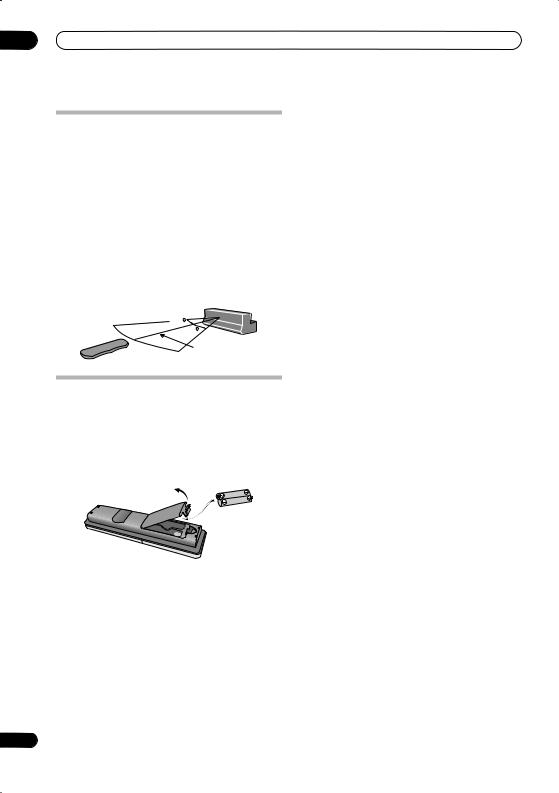
03 Controls and displays
Using the remote control
Please keep in mind the following when using the remote control:
•Make sure that there are no obstacles between the remote and the remote sensor on the unit.
•Remote operation may become unreliable if strong sunlight or fluorescent light is shining on the unit’s remote sensor.
•Remote controllers for different devices can interfere with each other. Avoid using remotes for other equipment located close to this unit.
•Replace the batteries when you notice a fall off in the operating range of the remote.
•Use within the operating range in front of the remote control sensor on the display unit, as shown.
30
30
23 ft.
Putting the batteries in the remote control
1Open the battery compartment cover on the back of the remote control.
2Insert two AA/R6 batteries into the battery
compartment following the indications ( , ) inside the compartment.
3 Close the cover.
 Caution
Caution
Incorrect use of batteries can result in hazards such as leakage and bursting. Please observe the following:
•Don’t mix new and old batteries together.
•Don’t use different kinds of battery together— although they may look similar, different batteries may have different voltages.
•Make sure that the plus and minus ends of each battery match the indications in the battery compartment.
16
•Remove batteries from equipment that isn’t going to be used for a month or more.
•When disposing of used batteries, please comply with governmental regulations or environmental public instruction’s rules that apply in your country or area.
 WARNING
WARNING
•Do not use or store batteries in direct sunlight or other excessively hot place, such as inside a car or near a heater. This can cause batteries to leak, overheat, explode or catch fire. It can also reduce the life or performance of batteries.
En

Getting started
Chapter 4
Getting started
System demo setting
Switches the automatic demo feature on or off (this starts when you plug in for the first time).
|
|
SLEEP |
ENTER |
CLEAR |
|
SETUP |
|
SR |
|
TUNE |
|
ST |
ST |
|
|
ENTER |
|
|
|
TEST |
SOUND |
|
TONE |
|
TUNE |
|
SOUND |
|
|
RETRIEVER |
|
|
SURROUND |
ADVANCED |
MCACC |
1Switch the system into standby.
2Press SETUP.
3Use the / (cursor left/right) buttons to select
DEMO from the menu, then press ENTER.
4Use the / (cursor up/down) buttons to select a setting, then press ENTER.
Select from:
•DEMO ON – Switches the demo display on.
•DEMO OFF – Switches the demo display off and the system into standby.
Using the Auto MCACC setup for optimal surround sound
The Multichannel Acoustic Calibration (MCACC) system measures the acoustic characteristics of your listening area, taking into account ambient noise, and testing for channel delay and channel level. After you have set up the microphone provided, the system uses the information from a series of test tones to optimize the speaker settings and equalization (Acoustic Calibration
EQ) for your particular room.1
 Important
Important
•The test tones used for Auto MCACC setup are loud; however, do not turn the volume down during setup as this may result in a sub-optimal setup.
•Make sure the microphone and speakers are not moved during the MCACC setup.
|
|
|
SETUP |
SR |
|
|
|
TUNE |
|
|
|
|
ST |
ST |
|
|
|
ENTER |
|
STANDBY/ON |
|
|
|
|
|
|
|
|
TEST |
|
|
MUTE |
SOUND |
TONE |
|
|
TUNE |
|
|
|
VOLUME |
|
|
|
|
|
|
SOUND |
|
|
|
|
RETRIEVER |
|
DVD |
DTV |
PC/GAME |
AUX |
|
|
|
|
SURROUND ADVANCED |
MCACC |
|
|
|
TUNER |
|
|
|
|
CHANNEL |
VOLUME |
1 Connect the microphone to the MCACC SETUP MIC jack on the rear panel.
|
|
|
|
|
|
ANTENNA |
|
|
|
|
|
|
MCACC |
CONTROL IN |
|
|
|
|
|
|
|
|
SETUP MIC |
|
|
|
|
|
|
|
|
|
|
|
|
FM |
|
|
AM |
|
|
|
|
|
|
UNBAL 75Ω |
|
LOOP ANTENNA |
|
|
|
|
|
|
|
|
AUDIO |
INPUT |
|
|
CONTROL |
|
SPEAKERS |
|
|
DIGITAL |
|
ANALOG |
|
SYSTEM CONNECTOR |
|
L |
DVD |
DTV |
PC/GAME |
AUX |
|||
OUT |
SUB WOOFER |
R SURROUND |
(COAXIAL) |
(OPTICAL) |
(OPTICAL) |
|
|||
|
|
|
|
|
|
|
|
|
L |
USE ONLY WITH DISPLAY UNIT. |
|
|
|
|
|
|
|
R |
|
SEE INSTRUCTION MANUAL. |
|
|
|
|
|
|
|
|
|
|
|
CENTER |
R |
FRONT |
L |
|
|
|
|
AC IN
04
English
2 Place the microphone at your normal listening position.
Place the mic horizontally about ear level at your normal listening position using a table or chair.
Make sure there are no obstacles between the speakers and the microphone.
 Note
Note
1 You only need to use the Auto MCACC setup once (unless you change the placement of your speakers or your room layout).
17
En

04 Getting started
3 If the receiver subwoofer is off, press STANDBY/ ON to turn the power on.
4 Press MCACC.
Try to be as quiet as possible after pressing MCACC. The volume increases automatically and the system outputs a series of test tones.
•To cancel Auto MCACC setup before it has finished, press MCACC. The unit will continue to use the previous settings.
•If the ambient noise level is too high, NOISY blinks in the display for five seconds. To exit and check the noise levels1, press MCACC, or to try again, press ENTER when RETRY shows in the display.
•If you see an ERR MIC or ERR SP message in the display, there may be a problem with your mic or the speaker connections. To try again, press ENTER when you see RETRY2
When the MCACC setup is complete, the volume level returns to normal, COMPLETE3 shows in the display, and Acoustic Calibration EQ is activated.4
 Note
Note
1• If the room environment is not optimal for the Auto MCACC setup (too much ambient noise, echo off the walls, obstacles blocking the speakers from the microphone) the final settings may be incorrect. Check for household appliances (air conditioner, fridge, fan, etc.), that may be affecting the environment and switch them off if necessary.
• Some older TVs may interfere with the operation of the mic. If this seems to be happening, switch off the TV during Auto MCACC setup.
2If this doesn’t work, press MCACC, turn off the power, and check the problem indicated by the ERR message, then try the Auto MCACC setup again.
3If COMPLETE doesn’t appear, it is likely an error occurred during the setup. Please check all connections and try again.
4See Listening with Acoustic Calibration EQ on page 21 to switch on/off Acoustic Calibration EQ.
18
En
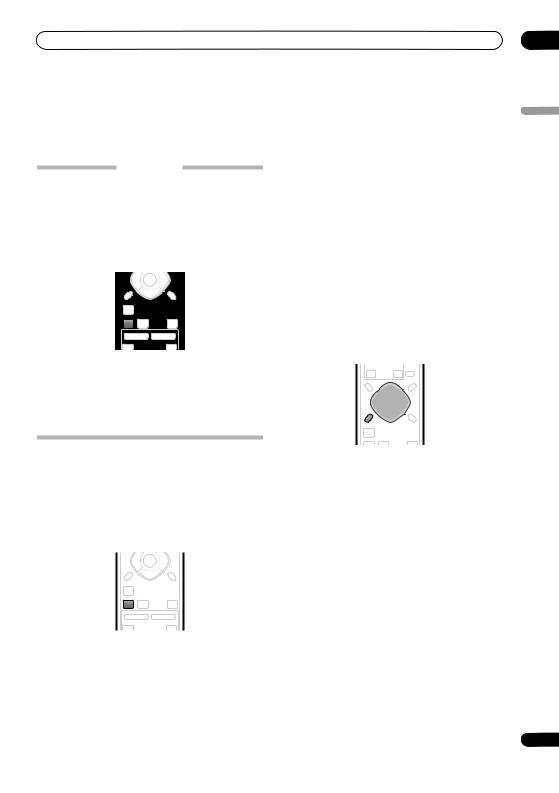
Listening to your system
Chapter 5
Listening to your system
Auto listening mode
The Auto listening mode is the simplest way to listen to any source as it was mastered: the output from the speakers mirrors the channels in the source material.
If you set up the system for Front surround (page 8), the Front Surround modes will give the best results (see
Using Front Surround on page 20).
ST |
ST |
ENTER |
|
|
TEST |
SOUND |
TONE |
TUNE |
|
SOUND |
|
RETRIEVER |
|
SURROUND ADVANCED |
MCACC |
CHANNEL |
VOLUME |
TV |
INPUT |
• Press SURROUND to select the AUTO listening mode.
If the source is Dolby Digital or DTS, the front panel 2 D or DTS indicator lights.
•You can also use the SURROUND button on the display unit to change the listening mode.
•AUTO – Auto listening mode (see above)
•DOLBY PL (Dolby Pro Logic) – 4.1 channel surround sound for use with any two-channel source
•MOVIE (Dolby Pro Logic II Movie) – 5.1 channel surround sound, especially suited to movie sources, for use with any two-channel source
•MUSIC (Dolby Pro Logic II Music) – 5.1 channel surround sound, especially suited to music sources, for use with any two-channel source; see Dolby Pro Logic II Music settings below
•STEREO – See Listening in stereo on page 20
Dolby Pro Logic II Music settings
When listening in Dolby Pro Logic II Music mode (see above), there are three settings you can adjust: Center Width, Dimension, and Panorama.
|
SLEEP |
ENTER |
CLEAR |
SETUP |
SR |
|
TUNE |
ST |
ST |
|
ENTER |
|
TEST |
SOUND |
TONE |
|
TUNE |
SOUND |
|
RETRIEVER |
|
SURROUND ADVANCED |
MCACC |
Listening in surround sound
You can listen to stereo or multichannel sources in surround sound. Surround sound is generated from stereo sources using one of the Dolby Pro Logic decoding modes.
If you set up the system for Front surround (page 8), the Front Surround modes will give the best results (see
Using Front Surround on page 20).
1With Dolby Pro Logic II Music mode active, press SOUND.
2Use / (cursor left/right) to select C WIDTH,
DIMEN. or PANORAMA then press ENTER.
•C WIDTH (Center Width): Provides a better blend of the front speakers by spreading the center channel between the front right and left speakers, making it sound wider (higher settings) or narrower (lower settings)
ST |
ST |
ENTER |
|
|
TEST |
SOUND |
TONE |
TUNE |
|
SOUND |
|
RETRIEVER |
|
SURROUND ADVANCED |
MCACC |
CHANNEL |
VOLUME |
TV |
INPUT |
• Press SURROUND repeatedly to select a listening mode.
•You can also use the SURROUND button on the display unit to change the listening mode.
The choices that appear in the display will vary according to the type of source that’s playing.
If the source is Dolby Digital or DTS, the front panel 2 D or DTS indicator lights.
•DIMEN. (Dimension): Adjusts the depth of the surround sound balance from front to back, making the sound more distant (minus settings), or more forward (positive settings)
•PANORAMA: Extends the front strereo image to include the surround speakers for a ‘wraparound’ effect.
3 Use / (cursor up/down) to adjust the setting then press ENTER to confirm.
05
English
19
En
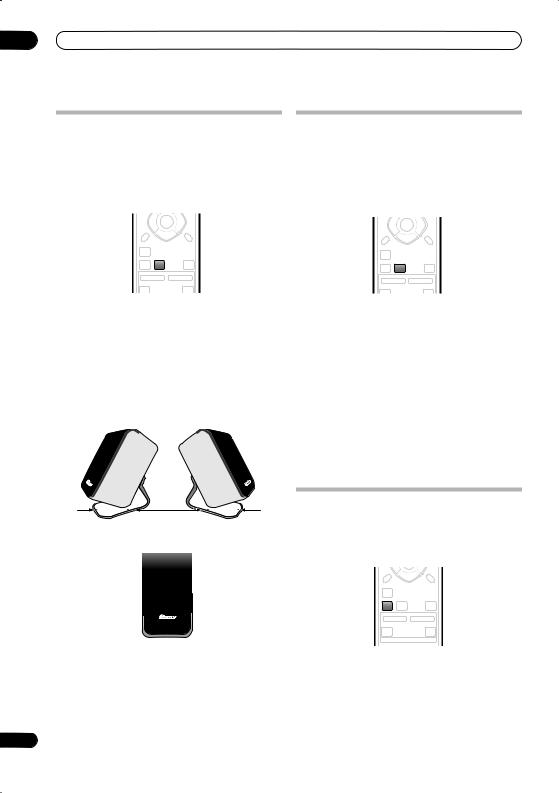
05 Listening to your system
Using Front Surround
The Front Surround modes are effective when you are using the Front surround speaker setup as described on page 8. The surround speakers should be placed beside the front speakers and oriented either towards the walls, or straight ahead, depending on which mode you are using (see below).
ST |
ST |
ENTER |
|
|
TEST |
SOUND |
TONE |
TUNE |
|
SOUND |
|
RETRIEVER |
|
SURROUND ADVANCED |
MCACC |
CHANNEL |
VOLUME |
TV |
INPUT |
• Press ADVANCED to select a Front Surround mode.
Press repeatedly to select FRTMOVIE, FRTMUSIC or
EXTPOWER.
•If you have selected FRTMOVIE (Front Surround Movie) or FRTMUSIC (Front Surround Music), turn each surround speaker so that the guide markers on the stand base are lined up horizontally in the direction the listening position (see below). With EXTPOWER (Extra Power), the surround speakers should point in the same direction as the front speakers (see below).
FRTMOVIE / FRTMUSIC
EXTPOWER
20
Using Advanced Surround
The Advanced Surround effects can be used with any multichannel or stereo source for a variety of additional surround sound effects.
If you set up the system for Front surround (page 8), the Front Surround modes will give the best results (see
Using Front Surround above).
ST |
ST |
ENTER |
|
|
TEST |
SOUND |
TONE |
TUNE |
|
SOUND |
|
RETRIEVER |
|
SURROUND ADVANCED |
MCACC |
CHANNEL |
VOLUME |
TV |
INPUT |
• Press ADVANCED to select an Advanced Surround mode.
Press repeatedly to select:
•ADVMOVIE – Suitable for movies
•ADVMUSIC – Suitable for music
•EXPANDED – Wide sound field
•TV SURR. – Surround sound for mono or stereo TV broadcasts
•SPORTS – Suitable for sports programming
•GAME – Suitable for TV game units
•VIRTUAL – A virtual surround effect using just the subwoofer and front speakers.
•5 STEREO – Powerful surround sound for stereo music sources
Listening in stereo
You can listen to any source—stereo or multichannel—in stereo. When playing a multichannel source, all channels are downmixed to the front left/right speakers and the subwoofer.
|
TEST |
SOUND |
TONE |
TUNE |
|
SOUND |
|
RETRIEVER |
|
SURROUND ADVANCED |
MCACC |
CHANNEL |
VOLUME |
TV |
INPUT |
TV CONTROL
• Press SURROUND repeatedly until STEREO shows in the display.
•You can also use the SURROUND button on the display unit to change the listening mode.
En
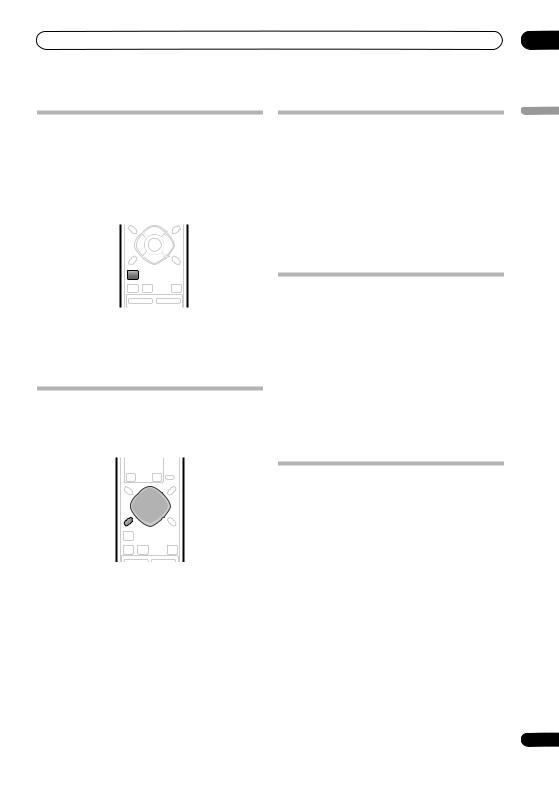
Listening to your system
Using the Sound Retriever
When audio data is removed during the MP3 or WMA compression process, sound quality often suffers from an uneven sound image. The Sound Retriever feature employs new DSP technology that helps bring CD quality sound back to compressed 2-channel audio by restoring sound pressure and smoothing jagged artifacts left over after compression.
TUNE |
|
ST |
ST |
ENTER |
|
|
TEST |
SOUND |
TONE |
TUNE |
|
SOUND |
|
RETRIEVER |
|
SURROUND ADVANCED |
MCACC |
CHANNEL |
VOLUME |
TV |
INPUT |
• While listening to a stereo source, press SOUND RETRIEVER.
Press repeatedly to switch between:
•RTRV ON — Switches the Sound Retriever on.
•RTRV OFF — Switches the Sound Retriever off.
Listening with Acoustic Calibration EQ
You can listen to sources using the Acoustic Calibration EQ set in Using the Auto MCACC setup for optimal surround sound on page 17.
|
|
SLEEP |
ENTER |
CLEAR |
|
SETUP |
|
SR |
|
TUNE |
|
ST |
ST |
|
|
ENTER |
|
|
|
TEST |
SOUND |
|
TONE |
|
TUNE |
|
SOUND |
|
|
RETRIEVER |
|
|
SURROUND |
ADVANCED |
MCACC |
CHANNEL VOLUME
1Press SOUND.
2Use the / (cursor left/right) buttons to select
MCACC EQ then press ENTER.
3Use the / (cursor up/down) buttons to switch
EQ ON or EQ OFF then press ENTER to confirm.
•On the EQ OFF setting, equalization is set to off and speaker settings (channel delay and channel level) remains as it is set.
•Acoustic Calibration EQ is set to on automatically after Auto MCACC setup is used.
Enhancing dialogue
The Dialogue Enhancement feature is designed to make the dialogue stand out from other background sounds in a TV or movie sound track.
1Press SOUND.
2Use the / (cursor left/right) buttons to select
DIALOGUE then press ENTER.
3Use the / (cursor up/down) buttons to select the amount dialogue enhancement then press ENTER to confirm.
Select between OFF, MID or MAX.
Using Quiet and Midnight listening modes
The Quiet listening feature reduces excessive bass or treble in a sound source.
The Midnight listening feature allows you to hear effective surround sound of movies at low volume levels.
1Press SOUND.
2Use the / (cursor left/right) buttons to select
TONE then press ENTER.
3Use the / (cursor up/down) buttons to select
QUIET or MIDNIGHT then press ENTER to confirm.
•To cancel the Quiet or Midnight listening modes, select BASS/TRE.
Adjusting the bass and treble
Use the bass and treble controls to adjust the overall tone.
1Press SOUND.
2Use the / (cursor left/right) buttons to select
TONE then press ENTER.
3Use the / (cursor up/down) buttons to select
BASS/TRE then press ENTER.
•Selecting BASS/TRE cancels the Quiet and Midnight listening modes. These modes cannot be used at the same time.
4Use the / (cursor left/right) buttons to select BASS or TREBLE; use the / (cursor up/down) buttons to adjust the sound then press ENTER to confirm.
05
English
21
En

05 Listening to your system
Boosting the bass level
There are two bass modes you can use to enhance the bass in a source.
1Press SOUND.
2Use the / (cursor left/right) buttons to select
BASSMODE then press ENTER.
3Use the /(cursor up/down) buttons to select the sound then press ENTER to confirm.
Select between OFF, MUSIC or CINEMA.
22
En
